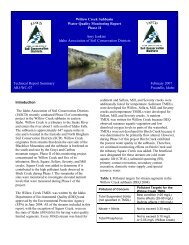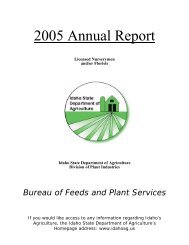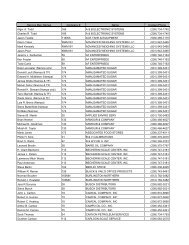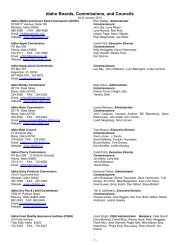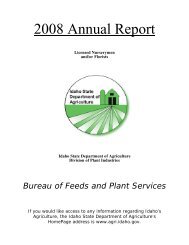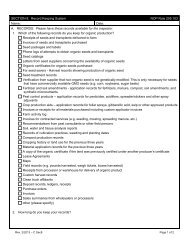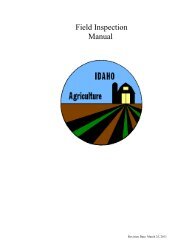2008 Statewide Strategic Plan for Eurasian Watermilfoil in Idaho
2008 Statewide Strategic Plan for Eurasian Watermilfoil in Idaho
2008 Statewide Strategic Plan for Eurasian Watermilfoil in Idaho
You also want an ePaper? Increase the reach of your titles
YUMPU automatically turns print PDFs into web optimized ePapers that Google loves.
Statutes and rules have been revised to address EWM control authority and expenditures with<strong>in</strong><br />
the ISDA. This enabled ISDA to quickly establish an <strong>in</strong>vasive aquatic plant management program<br />
where none existed previously. Early detection and rapid response (EDRR) is important when<br />
eradicat<strong>in</strong>g or attempt<strong>in</strong>g to conta<strong>in</strong> early <strong>in</strong>festations of <strong>in</strong>vasive aquatic species. Several federal,<br />
state, and local government agencies as well as Native American tribes have authorities <strong>in</strong> waters<br />
susceptible to or already <strong>in</strong>fested by EWM. A comprehensive state strategy needs to be developed<br />
to locate, manage, and assess control impacts related to EWM to conserve surface waterbody<br />
uses and functions with<strong>in</strong> the state of <strong>Idaho</strong>.<br />
ISDA Response: The Aquatic <strong>Plan</strong>ts Program Manager will be charged with develop<strong>in</strong>g a<br />
statewide strategy and track<strong>in</strong>g EWM population trends through time.<br />
Recommendation 2.1: Program responsibility<br />
The <strong>Idaho</strong> Legislature has designated the ISDA as the lead agency with the specific responsibility<br />
to coord<strong>in</strong>ate <strong>in</strong>vasive aquatic weed management issues. However, weed management<br />
operations are the responsibility of County Weed Super<strong>in</strong>tendents. Pert<strong>in</strong>ent statutes and rules<br />
should be revised to: rout<strong>in</strong>ely monitor the level of EWM <strong>in</strong>festation, clarify EWM management<br />
objectives, provide sufficient and recurr<strong>in</strong>g management fund<strong>in</strong>g, and evaluate the costeffectiveness<br />
of management programs. This <strong>in</strong>cludes the adoption of standard assessment<br />
techniques and weed mapp<strong>in</strong>g protocols. It is important <strong>for</strong> these parameters to be codified <strong>in</strong><br />
statute and rule to provide program consistency throughout the state as well as longevity of the<br />
program necessary <strong>for</strong> <strong>in</strong>vasive aquatic plant management. While most of the EWM management<br />
may be conducted by local entities, there needs to be statewide coord<strong>in</strong>ation and oversight. This<br />
level of oversight can be supplied with m<strong>in</strong>imal ISDA staff through statutory authorizations,<br />
delegations of authority and memoranda of understand<strong>in</strong>g among agencies with water resource<br />
management responsibilities, and through contracts with private companies to augment agency<br />
staff.<br />
ISDA Response: ISDA will explore the potential of additional statutory authorizations, but<br />
acknowledges its exist<strong>in</strong>g role to coord<strong>in</strong>ate weed management <strong>in</strong> the state. The Aquatic <strong>Plan</strong>ts<br />
Program Manager and ISDA GIS staff will evaluate standard assessment techniques <strong>for</strong> mapp<strong>in</strong>g<br />
protocols <strong>for</strong> submersed aquatic vegetation and provide some guidance as to which methods are<br />
feasible <strong>in</strong> <strong>Idaho</strong>.<br />
Recommendation 2.2: Staff<strong>in</strong>g<br />
The review panel feels strongly that to develop an efficient and publicly acceptable EWM<br />
management program it must <strong>in</strong>crease staff<strong>in</strong>g particularly at the field level. An overall program<br />
coord<strong>in</strong>ator should be stationed at the ISDA headquarters <strong>in</strong> Boise. Given the current distribution<br />
of EWM <strong>in</strong> <strong>Idaho</strong>, two field level regional biologists should be authorized by the legislature. These<br />
two <strong>in</strong>itial positions should be stationed one each <strong>in</strong> the northern area of the state, north of the<br />
Salmon River, and a second position stationed <strong>in</strong> the southwestern portion of the state. Periodic<br />
surveys of waterbodies <strong>in</strong> the southeastern portion of the state should be conducted and if EWM or<br />
other <strong>in</strong>vasive aquatic species are detected <strong>in</strong> that area, a third regional biologist should be<br />
allocated to that region. These positions will be a tremendous asset <strong>in</strong> the regional management<br />
and grantee oversight of the EWM management ef<strong>for</strong>ts. They could also play key roles <strong>in</strong> public<br />
coord<strong>in</strong>ation and education. Appendix 7 provides a position description <strong>for</strong> the Florida Regional<br />
Biologist with aquatic plant management, coord<strong>in</strong>ation and oversight responsibilities.<br />
ISDA Response: In response to this recommendation, ISDA is <strong>in</strong> the process of hir<strong>in</strong>g an Aquatic<br />
<strong>Plan</strong>t Program Manager. Additional staff is subject to the availability of fund<strong>in</strong>g to support these<br />
positions. ISDA concurs with this recommendation <strong>in</strong> that a regionalized ISDA presence is<br />
important to the long-term success of the program.<br />
61



